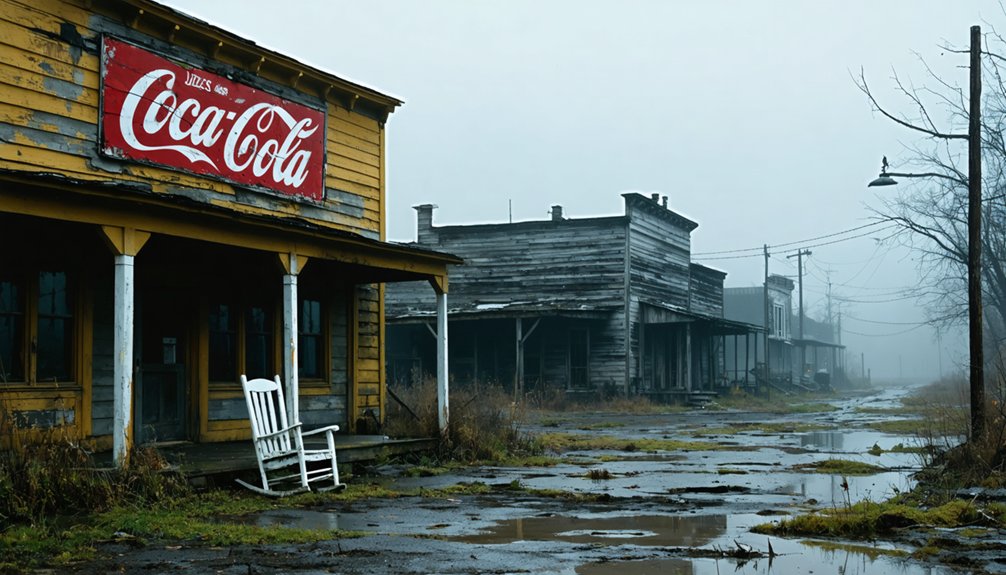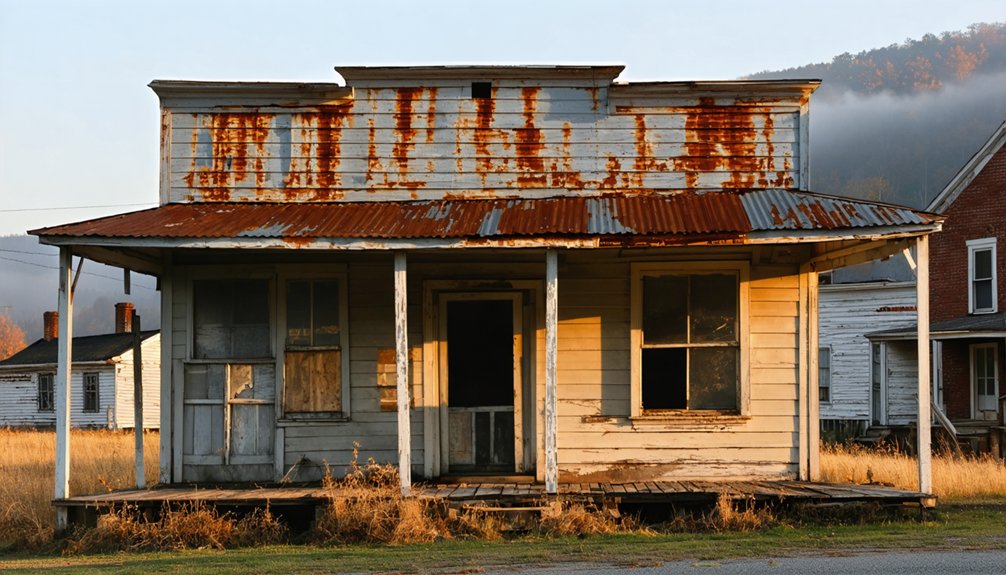You’ll find the ghost town of Fords Ferry at the former convergence of Crooked Creek and the Ohio River in Kentucky. This once-bustling river settlement, established by James Ford in the early 1800s, served as an essential crossing point for traders and settlers until its decline. The town’s dramatic history features Ford’s notorious criminal activities, thriving river commerce, and ultimately, devastating floods – including the catastrophic 1937 flood that sealed its fate. The ruins hold fascinating tales of prosperity, piracy, and pioneer life.
Key Takeaways
- Fords Ferry was a vital river crossing and trading post in Kentucky that eventually became a ghost town after the 1937 flood.
- The town’s decline began in the early 20th century with closure of essential services and exodus of residents to neighboring communities.
- James Ford operated the ferry service while secretly leading a criminal network, adding notorious historical intrigue to the abandoned town.
- Natural disasters, particularly flooding and erosion, contributed significantly to the town’s infrastructure damage and ultimate abandonment.
- Physical remains of Fords Ferry have largely disappeared, though local historical societies preserve its memory through documents and photographs.
The Rise of a River Settlement
Nestled at the convergence of Crooked Creek and the Ohio River, Fords Ferry emerged as an essential river settlement in Kentucky’s early frontier days. As pioneers faced the challenges of westward expansion, the strategic location proved crucial for those seeking to cross between Kentucky and Illinois.
Located where water meets wilderness, Fords Ferry became a vital crossing point in Kentucky’s pioneering era of westward movement.
You’ll find that river transportation shaped the town’s early identity, with the ferry service becoming the lifeline for traders, settlers, and travelers along the Tennessee-Illinois wagon trail. The settlement’s namesake James Ford established and operated the ferry crossing that would define the community’s purpose. Similar to other crossings of the era, simple rafts were the primary vessels used before more sophisticated boats were introduced.
The settlement quickly grew beyond its ferry origins, transforming into a bustling river community. Merchants and farmers recognized the location’s potential, establishing trade routes that connected the Kentucky wilderness with southern Illinois markets.
The ferry’s reliable service enabled the free flow of goods and people, cementing Fords Ferry’s position as a crucial transportation hub.
James Ford’s Dark Legacy
While James Ford maintained the facade of a respected civic leader and businessman in western Kentucky, you’ll find he secretly orchestrated a vast criminal network known as the Ford’s Ferry Gang from Cave-in-Rock along the Ohio River.
From his strategic position as both sheriff and ferry operator, Ford masterfully controlled river commerce and local law enforcement while running operations that included piracy, robbery, and illegal slave trading. His criminal enterprise was bolstered by his control of the 500-acre plantation in Tolu. He further expanded his influence by operating salt mines near the Great Salt Springs.
Your journey through Ford’s Ferry’s history wouldn’t be complete without noting his reign of terror ended in 1833 with his death, though the circumstances remain shrouded in mystery to this day.
Hidden Criminal Empire
Beneath a carefully cultivated public image as a respected businessman and militia officer, James Ford orchestrated one of the most extensive criminal networks along the Ohio River in the early 1800s.
After relocating with his mother to Princeton, Kentucky, he established himself in the region that would become the base for his criminal activities.
While serving as justice of the peace, he secretly directed the Ford’s Ferry Gang in river piracy, highway robbery, and illegal slave trading.
You’d find his operation’s true scope in the gang’s diverse criminal activities – from hijacking flatboats to collaborating with counterfeiters like the Sturdivant Gang.
Key associates included John Harmon and Isaiah L. Potts, while family members Philip and William Ford helped maintain the enterprise.
His ruthless operation utilized Cave-in-Rock as a strategic headquarters for coordinating criminal activities along the waterway.
Despite hundreds of travelers reportedly falling victim to robbery and murder, Ford’s respected position in the community kept suspicions at bay, allowing his criminal empire to thrive unchecked along the Kentucky-Illinois border.
Respected Leader’s Fatal End
After years of masterfully balancing his dual roles as community leader and criminal mastermind, James Ford met a violent end on July 5, 1833, near his family farm in Tolu, Kentucky.
The circumstances of his death remain disputed – some say a posse captured him, while others claim Simpson’s son fired through a cabin wall at point-blank range.
You’ll find Ford’s final moments marked by resigned acceptance. When his captors offered him supper, he declined, knowing his fate was sealed.
This conflicted legacy continues to intrigue historians – was he truly “Satan’s Ferryman” or a maligned public servant?
While no legal evidence ever convicted him, Ford’s death marked the end of an era of organized river crime.
His children later married into respected families, preserving their social standing despite their father’s notorious reputation.
During Ford’s burial, a fierce storm interrupted the ceremony, causing his slaves to view it as an ominous sign.
Operating from Cave-in-Rock area, Ford’s gang conducted their criminal activities targeting travelers and settlers along the Ohio River.
Life Along the Ohio River
During the heyday of river commerce, life along the Ohio River at Fords Ferry centered on the waterway’s crucial role in transportation, trade, and community development.
The river’s presence shaped daily existence, with locals adapting to both its benefits and dangers. Through river transportation, the town flourished as a critical crossing point between Kentucky and Illinois, while community resilience helped residents weather natural challenges like flooding. The Fords Ferry Gang operated in the area, creating an atmosphere of danger for legitimate travelers and merchants. Audio stories from the library’s Dial-A-Story line now help visitors understand this tumultuous era.
- The Bell City House hotel, general store, and fish market served travelers and locals alike, creating a bustling river town atmosphere.
- Dense forests along the riverbanks provided resources but also concealed dangers, from outlaws to treacherous conditions.
- Families built their lives around the river’s rhythm, relying on its waters for commerce while staying vigilant against its destructive potential during flood seasons.
Economic Growth and Commerce
While James Ford’s ferry operation laid the foundation for Fords Ferry’s growth, the town’s economy quickly expanded beyond simple river crossings to become a thriving commercial hub along the Ohio River.
The trade dynamics revolved around a bustling wharf where merchants loaded and unloaded goods, while the Bell City House provided lodging for weary travelers. You’d have found a diverse mix of businesses, including general stores, a millinery shop, and a fish market, all serving both locals and river traffic.
The town’s strategic location and ferry operations attracted steady commercial activity, supported by Lock and Dam 50.
A post office, established in 1854, and well-maintained roads further cemented Fords Ferry’s position as a significant regional trading post along the Ohio River.
Daily Life in Fords Ferry

Life in Fords Ferry centered around the bustling Ohio River waterfront, where residents balanced small-town closeness with the constant flow of travelers and commerce.
The heart of Fords Ferry pulsed along the Ohio River, where local life and passing commerce mingled in perfect harmony.
You’d find families like the Prices gathering at community events while merchants served both locals and passing traders. The town’s fabric wove together education, commerce, and daily necessities, creating a vibrant river community until flooding ultimately sealed its fate.
- Your daily errands might include visits to the village store-post office, millinery shop, or fish market for fresh river catch.
- Your children would attend the local school while you’d tend to business at the blacksmith or pick up supplies at the drug store.
- You’d likely participate in family gatherings at the Bell City House, which served as a social hub for both residents and travelers.
Natural Disasters and Challenges
Despite its strategic location at the confluence of Crooked Creek and the Ohio River, Fords Ferry faced relentless environmental challenges that would ultimately lead to its downfall.
You’ll find no evidence of flood management systems in the historical record, leaving the town vulnerable to nature’s fury. While residents rebuilt after several floods in the early years, their resilience couldn’t match the river’s persistence.
The catastrophic 1937 flood delivered the final blow. With limited resources for disaster recovery and a dwindling population, most residents chose not to return.
The dual assault of water from both Crooked Creek and the Ohio River had proven too formidable, and erosion only compounded the damage. What was once a bustling riverside community succumbed to the power of these waterways.
The Town’s Final Days

As the early 20th century dawned, Fords Ferry‘s once-bustling riverfront entered its final chapter.
You’d have witnessed the town’s slow transformation into a ghost town as businesses shuttered and residents sought opportunities elsewhere.
The community’s final days were marked by three distinct phases:
Like chapters in a closing book, the town’s decline unfolded in three clear stages before fading into history.
- The closure of essential services – the post office, hotel, and local stores that had served as community anchors.
- The deterioration of infrastructure without maintenance or investment, leaving buildings to crumble.
- The exodus of remaining families as modern amenities and economic prospects drew them to neighboring towns.
Even the ferry service, which had defined the town’s existence since James Ford’s era, lost its relevance as new transportation routes emerged.
Today, Fords Ferry stands as a monument to how changing times can transform a thriving river town into a forgotten footnote in history.
Preserving the Historical Memory
While physical remnants of Fords Ferry have largely vanished, dedicated community efforts keep the town’s rich history alive through oral traditions, family records, and local archives.
You’ll find the town’s legacy preserved primarily through community storytelling, where descendants of original residents share tales passed down through generations. Local historical societies and libraries maintain valuable collections of photographs, documents, and personal accounts that paint a vivid picture of frontier life along the Ohio River.
Historical documentation reveals James Ford’s complex role as both civic leader and alleged river pirate, adding intrigue to the town’s narrative.
Though floods and time have erased the physical structures, the cultural memory of Fords Ferry endures through academic research, family histories, and regional folklore that continue to captivate those interested in Kentucky’s river town heritage.
Frequently Asked Questions
Were There Any Documented Murders of Travelers at Ford’s Ferry?
While you’d expect travelers’ safety records from that era, historical accounts confirm numerous murders by James Ford’s gang, who robbed and killed settlers crossing the Ohio River, though exact numbers remain uncertain.
What Happened to James Ford’s Family After His Assassination?
You’ll find the Ford family aftermath was surprisingly positive – they kept their property, married into prominent local families, and maintained respectability. Their historical legacy shifted from outlaw connections to prosperous citizenship.
Did Any Native American Tribes Have Settlements Near Ford’s Ferry?
Like shadows on ancient waters, you’ll find the Shawnee established villages near the Ohio River’s banks, while Fort Ancient peoples, Seneca, and Delaware tribes left their marks around Fords Ferry’s crossing paths.
What Was the Average Ferry Crossing Fee During Ford’s Operation?
Based on ferry history records from the Kentucky region, you’d have paid around 5 cents per person, 19 cents with a horse, or up to 36 cents for crossing prices with larger wagons.
Were There Any Documented Supernatural Occurrences or Ghost Stories?
You’re barking up the wrong tree if you’re seeking ghostly legends. Historical records don’t show any documented supernatural occurrences or haunted locations connected to the site, despite its dark criminal past.
References
- http://ourforgottenpassages.blogspot.com/2015/03/a-look-back-at-fords-ferry-ky.html
- https://en.wikipedia.org/wiki/James_Ford_(pirate)
- http://ourforgottenpassages.blogspot.com/2019/08/fords-ferry-road-was-dangerous-route.html
- https://www.youtube.com/watch?v=D9gOmfCuKLs
- https://drloihjournal.blogspot.com/2018/02/james-ford-leader-of-fords-ferry-gang-river-pirates.html
- http://www.illinoishistory.com/jamesford.html
- https://completely-kentucky.fandom.com/wiki/James_Ford
- https://www.sokyhappenings.com/2021/08/remembering-ferryboats/
- https://www.kentuckyliving.com/lifestyle/uniquely-kentucky/crossing-the-river
- https://kids.kiddle.co/James_Ford_(pirate)



